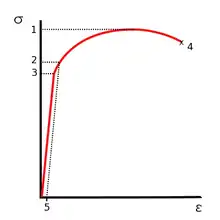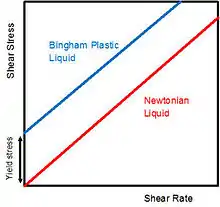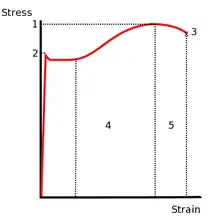استحکام تسلیم
استحکام تسلیم یا تنش تسلیم[1] (به انگلیسی: Yield stress) در جامدات به میزان تنش مربوط به انتهای بخش خطی منحنی تنش-کرنش در آزمون کشش تکمحوره[2] و در سیالات (غیرنیوتنی) به مقدار تنشی که با کاهش آن سیال رفتار شبه جامد (تغییرشکل ناپیوسته) پیدا میکند گفته میشود.[3]
از آنجایی که تعیین دقیق مقدار تنش تسلیم امکانپذیر نیست،[4] تنش تسلیم جامدات در کاربردهای مهندسی به مقدار تنشی گفته میشود که باعث ایجاد تغییر فرم پلاستیک محسوس[5] یا کرنش به میزان قراردادی (معمولاً در فلزات کرنش دائمی 0.002[6] یا کرنش کل 0.005[7] و در پلیمرها کرنش دائمی 0.001[8]) شود. این مقدار تا حد زیادی به دقت و قرارداد اندازهگیری آن وابستهاست.[9]
در جامدات
فولاد سازهای یک نمونه از موادی است که رفتار الاستیک-پلاستیک غیریکنواخت، پلاستیک یکنواخت از خود نشان میدهند. در این مواد انتقال از تغییر شکل الاستیک به پلاستیک به صورت کاملاً مشخص است. در این مواد پس از تسلیم (تسلیم بالایی) به دلیل آزاد شدن قفلهای لومر-کاترل و تشکیل نوارهای لودر تنش تا میزان تسلیم پایینی کاهش مییابد.[10] این پدیده، «پدیده نقطه تسلیم» نامیده میشود.[11] در این نوع مواد تنش تسلیم بالایی به شدت به نرخ کرنش وابستهاست بنابراین تنش تسلیم پایینی، تنش تسلیم محسوب میشود.[12][13]

آلومینیوم یک نمونه از موادی است که رفتار الاستیک-پلاستیک یکنواخت از خود نشان میدهند. در این مواد مرز مشخصی بین ناحیهٔ تغییر شکل الاستیک و تغییر شکل پلاستیک وجود ندارد.[14]
در سیالات

در سیالات پلاستیک بینگهام و هرشل-بالکلی تنش برشی بحرانی که باعث آغاز شارش میشود، تنش تسلیم نامیده میشود. برای اندازهگیری تجربی دقیق مقدار تنش تسلیم در سیالات بایستی ویسکوزیتهٔ ظاهری را در نرخ برش بسیار کم بررسی کرد.[15] از دیدگاه فیزیکی تنش تسلیم سیالات یک تکمقدار اسکالر نبوده و محدودهٔ گذار از حالت جامد به مایع است.[16]
پانویس
- Mitchell, An introduction to materials..., 396.
- Cardarelli, Materials Handbook, 9.
- Barnes, “The yield stress...”, 137.
- Rösler, Harders and Bäker, Mechanical Behaviour of Engineering Materials, 69.
- Hosford, Mechanical Behavior of Materials, 36.
- Dieter and Bacon, Mechanical Metallurgy, 9.
- Hosford, Mechanical Behavior of Materials, 38.
- Ashby, Shercliff and Cebon, Materials Engineering, Science..., 112.
- Lyklema and Van Olphen, “Terminology and Symbols in Colloid...”, 1217.
- Hertzberg, Deformation and Fracture Mechanics..., 30.
- Callister, Materials science and engineering..., 144.
- Callister, Materials science and engineering..., 144.
- Tomota, Springer Handbook of Materials..., 337.
- Hertzberg, Deformation and Fracture Mechanics..., 17.
- Braun and Rosen, Rheology Modifiers Handbook, 36.
- Aksel and Heymann, Springer Handbook of Experimental..., 694.
منابع
- Aksel, Nuri; Heymann, Lutz (2007). "Non-Newtonian Flows". In Tropea, Cameron; Yarin, Alexander; Foss, John F. Springer Handbook of Experimental Fluid Mechanics. Berlin: Springer Science+Business Media, Inc. ISBN 978-3-540-25141-5.
- Ashby, Michael; Shercliff, Hugh; Cebon, David (2007). Materials Engineering, Science, Processing and Design. UK: Elsevier Ltd. ISBN 0-7506-8391-0.
- Barnes, Howard A (1999). "The yield stress—a review or 'παντα ρει'—everything flows?". J. Non-Newtonian Fluid Mech. 81: 133-178. doi:10.1016/S0377-0257(98)00094-9.
- Braun, David B; Rosen, Meyer R (2000). Rheology Modifiers Handbook. New York, USA: William Andrew Publishing. ISBN 0-8155-1441-7.
- Callister, William D (2007). Materials science and engineering: an introduction (7 ed.). New Jersey, USA: John Wiley and Sons, Inc. ISBN 0-471-73696-1.
- Cardarelli, François (2000). Materials Handbook (2 ed.). London, UK: Springer-Verlag. ISBN 978-1-84628-668-1.
- Dieter, George E; Bacon, David (1988). Mechanical Metallurgy. UK: McGraw-Hill. ISBN 0-07-100406-8.
- Hertzberg, Richard W (1996). Deformation and Fracture Mechanics of Engineering Materials (4 ed.). USA: John Wiley and Sons, Inc. ISBN 0-471-01214-9.
- Hosford, William F (2010). Mechanical Behavior of Materials (2 ed.). Cambridge, UK: Cambridge University Press. ISBN 978-0-521-19569-0.
- Lyklema, J; Van Olphen, H (1979). "Manual of symbols and terminology for physicochemical quantities and units. Appendix II: Definitions, terminology and symbols in colloid and surface chemistry. Part 1.13. Selected definitions, terminology and symbols for rheological properties". Pure and Applied Chemistry. International Union of Pure and Applied Chemistry. 51 (5): 1213-1218. doi:10.1351/pac197951051213.
- Mitchell, Brian S (2004). An introduction to materials engineering and science: for chemical and materials engineers. New Jersey, USA: John Wiley and Sons, Inc. ISBN 0-471-43623-2.
- Rösler, Joachim; Harders, Harald; Bäker, Martin (2007). Mechanical Behaviour of Engineering Materials. Berlin: Springer-Verlag. ISBN 978-3-540-73446-8.
- Tomota, Yo (2006). "Mechanical Properties". In Czichos, Horst; Saito, Tetsuya; Smith, Leslie. Springer Handbook of Materials Measurement Methods. UK: Springer Science+Business Media, Inc. ISBN 3-540-20785-6.

